I can sincerely say that I adore rice. And Risotto is no stranger in my world. I love risottos of any kind, and I love to experiment from time to time. However, there are times when classic recipes trump some of the most creative attempts. Risotto con funghi is one of those recipes. Mushroom Risotto Recipe 4 cups chicken broth, low sodium 1 1/2 tablespoons olive oil, divided 1/2 onion, diced, divided 1 garlic cloves, minced, divided 1/2 pound fresh portobello and crimini mushrooms, sliced 1 bay leaves 1 tablespoons fresh thyme, chopped 1 tablespoons fresh Italian parsley, chopped 1 tablespoons butter Salt and pepper 2 tsps truffle oil 1-ounce dried porcini mushrooms, wiped of grit 2 cups Arborio rice 1/4 cup dry white wine 1/4 cup fresh Parmesan cheese, grated Fresh Italian parsley, for garnish Heat the chicken broth in a medium saucepan and keep warm over low heat. Heat 1 tablespoon of oil in a large skillet over medium heat. Add 1/2 onion and 1 clove garlic, cook, stirring, until translucent, about 5 minutes. Add the fresh mushrooms, herbs and butter. Saute for 3 to 5 minutes until lightly browned, season with salt and pepper. Drizzle in truffle oil then add the dried porcini mushrooms which were reconstituted in1 cup of warm chicken broth. Season again with salt and fresh cracked pepper. Saute 1 minute then remove from heat and set aside. Coat a saucepan with remaining 2 tablespoons of oil. Saute the remaining 1/2 onion and garlic clove. Add the rice and stir quickly until it is well-coated and opaque, 1 minute. This step cooks the starchy coating and prevents the grains from sticking. Stir in wine and cook until it is nearly all evaporated. Now, with a ladle, add 1 cup of the warm broth and cook, stirring, until the rice has absorbed the liquid. Add the remaining broth, 1 cup at a time. Continue to cook and stir, allowing the rice to absorb each addition of broth before adding more. The risotto should be slightly firm and creamy, not mushy. Transfer the mushrooms to the rice mixture. Stir in Parmesan cheese, cook briefly until melted. Top with a drizzle of truffle oil and chopped parsley before serving. 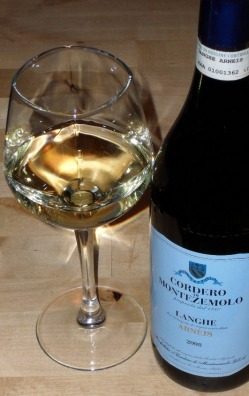 2008 Cordero di Montezemolo Langhe Arneis The Langhe is an area of Piedmont located in the province of Cuneo. Home of Asti, Barolo, Barbaresco, Dogliani and Neive, just to mention the most known villages, it is without a doubt the most important wine growing region of Piedmont. Arneis is an ancient local white grape historically known as Nebbiolo Bianco, probably because it used to be blended to Nebbiolo, in order to soften its austere flavor. Being Piedmont a red wine region, only in the early 70s, when the consumers began to drink more white wines, some local producer tried to make wine with 100% Arneis. Today it is made in the DOCG Roero Arneis, and in the DOC Langhe Arneis, the latter being the one with more body. This wine has been fermented in stainless steel vats; left on lees for about one month for malolactic fermentation, then drawn off and allowed to clarify naturally in stainless steel tanks. Finally, aged for two months in the bottle before release. Tasting notes: Straw color. Ripe pear, roasted almond, flint and flowers on the nose. Full bodied, dry and silky on the palate. Flavors of pear, lemon, minerals and a little bitterness are followed by a medium acidity and an aftertaste of honey suckle (retail $14.99 - AVIN6952394965783).
0 Comments
There are not many recipes in Julia Child's "Mastering the Art of French Cooking" that I would make again and again-- except this one. The Coq au Vin dish from her book is to her credit quite marvelous. If you are a chicken lover and if you have never tried this dish, I strongly urge you to give it a try. Coq Au Vin is a Burgundian dish, and is considered a French comfort food. The traditional recipe for Coq au Vin did not include chicken, but rather a "Coq", which is a rooster. A lot of recipes originally called for old barnyard fowl, roosters, capon (a de-sexed rooster), and old laying hens. Coq au Vin was originally considered peasant food, and the farmers would make do with what they had on hand. The red wine in the recipe was used not to mask flavor, but to allow the acids to help break down the old meat of the rooster. True coq Au Vin was actually finished with the blood of the rooster stabilized with brandy and vinegar, this would help the blood not clot. You can find her recipe here  2005 Château de Paillet-Quancard Premières Côtes de Bordeaux
Red Bordeaux is probably one of my least favorite subjects; not because I do not like those wines, as I think in good vintages they are the best expression of the Cabernet Sauvignon and Merlot grapes, but because in order to get a good bottle of wine one has to spend at least $25. Following the advise of my wine merchant, I have purchased this 2005 Premières Côtes de Bordeaux, as this vintage is known as the latest great one in Bordeaux. The Premières Côtes de Bordeaux is a French AOC located in the Entre-Deux-Mers region, the triangular area between the Dordogne and the Garonne rivers. Its wines are Merlot based and represent a good value, with prices starting from the $15. They are made for early drinking, but they keep well and develop with age. Julia Child's book pairs this dish with red Burgundy or Cru Beaujolais, but I felt the dish might overpower those wines, so I selected this Merlot based Bordeaux because it has more body and a balanced fruity/earthy profile. The blend is 80% Merlot, 15 Cabernet Sauvignon, 5% Cab Franc. It has been fermented in in temperature controlled stainless steel and cement vats, with 3 weeks of maceration followed by aging in oak barrels for 10 months. One third of the barrels are renewed each year. Tasting notes: A deep purple color shows this wine is still pretty young. On the nose, it opens with an intense bouquet of plum and blackberry, along with chalky notes and hints of dried herbs and old leather. Medium bodied with gripping tannins and high acidity providing a firm backbone. Good mix of dark and candied fruit flavors, chalkiness, oak and green vegetables, the latter carrying throughout the finish. It's not the wine that blow your socks off, but definitely a good value for an entry level Bordeaux (retail $12.99 - AVIN8106597223951) 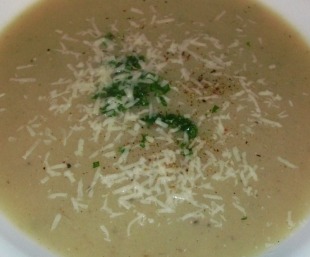 I love soup! I think it is one of the best ways to comfort your soul and put a smile on your face at the same time. The combination here was a recipe that I came up with because I was playing "iron chef" with the remains of my fridge and pantry. Sometimes my rants in the kitchen are always not so successful and sometimes magic happens. I have to admit, this was definitely a good ending to the day.
16 oz of chicken or vegetable stock 3 baking potatoes, peeled and chopped 1 med onion, sliced 1/2 cauliflower,chopped 2 cloves garlic, minced 1 Tbsp olive oil 2 or 3 bay leaves 1 tsp dried thyme 1 tsp celery salt truffle oil salt and pepper to taste Boil potatoes in a stockpot with broth and 2 cups of water. Meanwhile, in a skillet, saute onions and garlic in olive oil until translucent. Transfer to stockpot with potatoes. Add the cauliflower, bay leaves, celery salt, and thyme. Cook for 45mins to 1 hour on med-low to low heat. Remove Bay leaves and blend in a blender and return to heat for 10 mins longer. Salt to taste and serve in bowls and garnish with chopped parsley. Drizzle truffle oil on top. We do not pair wine with hot soups. This was a wonderful combination of flavors. I got the inspiration from a traditional Vodka sauce, but decided to try adding some Fino sherry instead. It was certainly a delicious success. 4oz Salmon (cooked or broiled for 5 mins) 2Tbsp olive oil frozen peas 2 Tbsp tomato paste 1/4 cup fish stock or water 1/2 cup chopped onions 4 Tbsp heavy whipping cream 1/4 cup Fino sherry fettuccine pasta Cook pasta per directions. In the meantime, saute onions in oil over med heat. When onions are translucent, add tomato paste and cream until well distributed. Pour in the sherry and the fish stock and cook until boiling. Reduce heat to simmer and add frozen peas and salmon. Toss with pasta and season with salt and pepper. 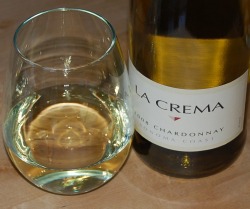 2008 La Crema Sonoma Coast Chardonnay
Salmon and Chardonnay is one of our favorite pairings. This fish is so rich, that can be paired with light red wine too; however we prefer a full bodied white. Chardonnay is all about winemaking. As the grape itself is quite neutral in aroma and flavor, what the wine will become depends on the work done at the winery. The grapes for this vintage have been harvested from cool vineyard sites in the Sonoma Coast AVA. In order to achieve a richer texture, 70% of the wine underwent malolactic fermentation, and it has been aged on its lees for 7 months in mostly French oak (20% new). Here we wanted to pair the creaminess with the dish with the creamy texture of a barrel aged Chardonnay. Tasting notes: Clear, light golden color. Pineapple, butterscotch and a hint of minerals on the nose. Full bodied with creamy texture and a surprising acidity. The palate confirms the nose, with the addition of a lemon/lime note on the finish. Good balance of ripe fruit and new oak influence, with a fresh kick of acidity. Tasted at room temperature, it finishes a little hot, but below 60°F it is hard to perceive. The problem with this wine is that the longer it stays open the more it smells and taste like oak and vanilla only (retail $16.99 - AVIN7104634614855) . 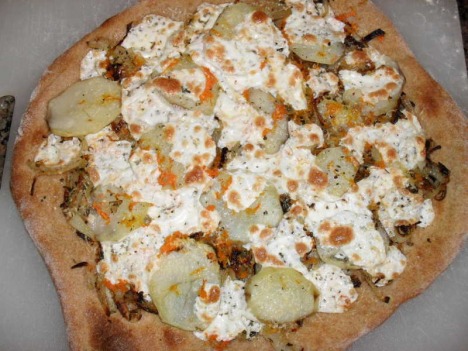 Mmmmmmm... PIZZA.... Ok- So we know that this is Nic's fav food, but he has never tried this version-- with potatoes! And just let me tell you that this is not your ordinary pizza. I made the pizza dough adapted from Peter Reinhart's recipe. The Dough: Makes 4 10-inch pizzas 5 cups whole wheat flour 1 Tablespoon sugar or honey 2 teaspoons salt (or 3 1/2 teaspoons kosher salt) 1 teaspoon instant yeast (I used 1/2 cup wild yeast) 2 Tablespoons olive oil 1 3/4 to 2 cups room-temperature water Combine all of the ingredients in a large mixing bowl and stir vigorously with a wooden spoon or mix in an electric mixer. After you've combined all of the ingredients, set the dough aside to rest for 5 minutes. Stir again for 3 to 5 minutes, adding more water or flour if necessary. Generally speaking, you want the dough to be wetter and stickier than your typical bread dough. It should be dry enough that it holds together and pulls away from the side of the bowl when you mix it, but it doesn't need to be dry enough to knead by hand. Divide the dough into 4 pieces. Put the dough in a bag and refrigerate for at least 4 hours. (you can halve the recipe to make only 2 pizzas) Remove them from the fridge and let them warm to room temperature an hour or two before you intend to bake them. Flatten out into circles by either rolling with a rolling pin or stretching out by hand. Top with: caramelized onions, rosemary, sliced preboiled potatoes and mozzarella cheese. Bake in a preheated 500 degree oven on a pizza stone if you have one. Bake for 8-10mins and you will be rewarded with an amazing pie! 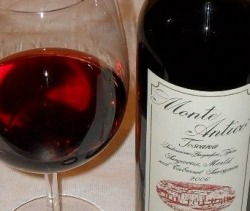 2006 Monte Antico Toscana IGT
When it comes to pizza, my favorite pairing is beer. Yes, I have to admit, although I'm Italian, I used to be a beer drinker, and I still enjoy a fresh draught. However, talking wine, you say pizza, I say Sangiovese. Why? Because pizza is basically a piece of bread with cheese, tomato and basil leaves on top of it. Rustic, isn't it? Which is also the best descriptor for the (Italian) Sangiovese grape. Since Sandra gave our pizza a twist, instead of pairing it with a wine made from 100% Sangiovese grapes, I picked a "Baby super Tuscan" or Toscano IGT: a blend of Sangiovese and French varietals. This wine is a blend of 85% Sangiovese, 10% Cabernet Sauvignon and 5% Merlot. It has been fermented in stainless steel tanks, followed by maceration for 15-20 days and aged 1 year in oak (80% Slovenian and 20% French). Tasting notes: Garnet color with slight discoloration on the rim. The nose is quite aromatic, especially after it sits for 30 minutes. It has the earthy aroma typical of the Sangiovese grape, and the sour cherry turns slowly into ripe black cherry. There is some black currant too, as well as mild toasty notes. Medium/full bodied with smooth tannins and silky texture. Dark fruit, a gentle touch vanilla and dry soil on the palate, along with tomato leaves. The ripe fruit balances the sharp acidity of this wine, but it finishes a little short. Well made wine with a modern profile (Monte Antico is a proprietary label of Empson, a US based importer). It pairs with pizza, salumi and pasta with marinara sauce (retail $10.99 - AVIN3601780421602). |
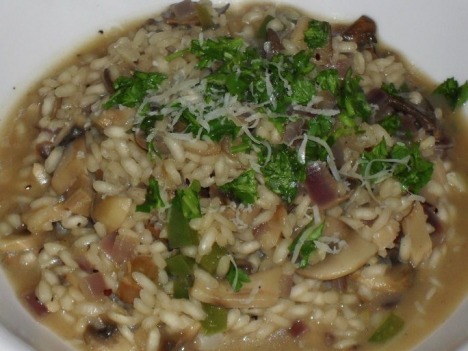

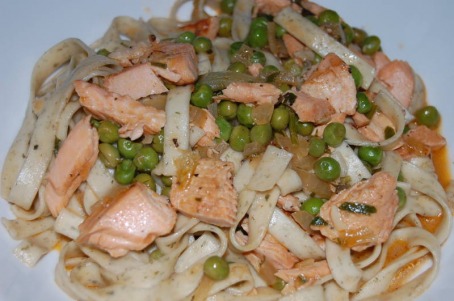

 RSS Feed
RSS Feed